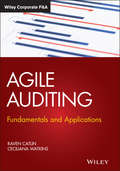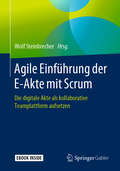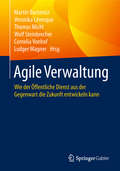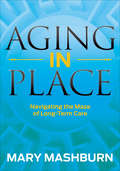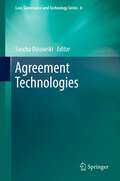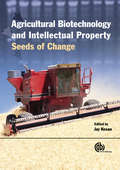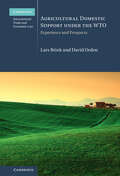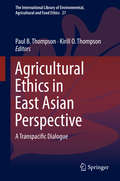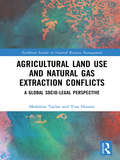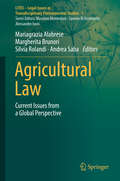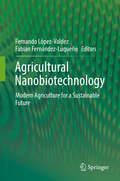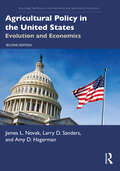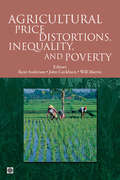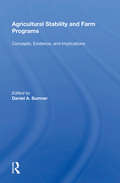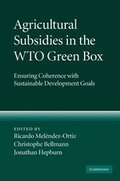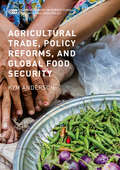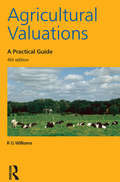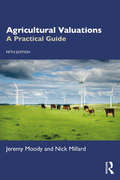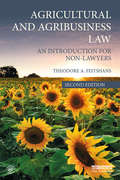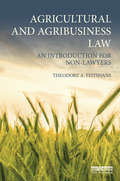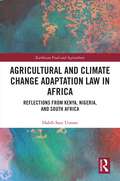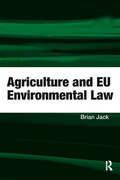- Table View
- List View
Agile Auditing: Fundamentals and Applications (Wiley Corporate F&A)
by Raven Catlin Ceciliana WatkinsMaster new, disruptive technologies in the field of auditing Agile Auditing: Fundamentals and Applications introduces readers to the applications and techniques unlocked by tested and proven agile project management principles. This book educates readers on an approach to auditing that emphasizes risk-based auditing, collaboration, and speedy delivery of meaningful assurance assessments while ensuring quality results and a focus on the areas that pose the greatest material risks to the business under audit. The discipline of auditing has been forever changed via the introduction of new technologies, including: Machine learning Virtual Conferencing Process automation Data analytics Hugely popular in software development, the agile approach is just making its way into the field of audit. This book provides concrete examples and practical solutions for auditors who seek to implement agile techniques and methods. Agile Auditing is perfect for educators, practitioners, and students in the auditing field who are looking for ways to introduce greater levels of efficiency and effectiveness to their discipline.
Agile Einführung der E-Akte mit Scrum: Die digitale Akte als kollaborative Teamplattform aufsetzen
by Wolf SteinbrecherDieses Buch nimmt Ihnen Ihre Unsicherheit bei der Einführung der E-Akte Die Digitalisierung macht auch vor der Dokumentenverwaltung in Behörden oder größeren Organisationen nicht Halt. Um in diesem Bereich vorherrschende Unsicherheiten abzubauen und die Aktenführung im Sinne der Verwaltung 4.0 im Zeitalter der Digitalisierung voranzutreiben, hat Wolf Steinbrecher dieses Buch über die Einführung der E-Akte (elektronische Akte) herausgegeben. Es begleitet Sie bei jeder Phase eines solchen Projekts und stellt agile Vorgehensweisen detailliert dar:Vision der E-Akte und digitaler mehrdimensionaler AktenplänenVorstellung eines Musterlastenhefts und eines agilen Vertrags nach EVB-ITGestaltung von Abteilungsworkshops beim Roll-outLesen Sie in diesem Buch außerdem nach, wie Sie Ihre Mitarbeiter vom Nutzen der Einführung von E-Akten überzeugen und sie in die aktive Mitgestaltung einer neuen Arbeitsumgebung miteinbeziehen. Denn nur so sind Sie in der Lage, die Digitalisierung in der (öffentlichen) Verwaltung im Sinne des papierlosen Büros zu einem Erfolgsprojekt zu machen. Zukunftsweisende Impulse für jede ProjektphaseDieses Buch untergliedert die Einführung der E-Akte in drei Teile. Erfahren Sie zunächst, wie Sie Ihre Vision des Arbeitens mit digitalen Akten richtig formulieren. Anschließend zeigen Ihnen die Verfasser einen idealen Projektverlauf auf, bevor die Implementierung neuer Prozesse im Vordergrund steht. Daneben befasst sich dieses Werk auch mit diesen Schwerpunkten: Problem: SchnittstellenKick-off in einer AbteilungEinen Prozess ins DMS überführenBieterpräsentationen vorbereitenPraktische Tipps, beispielsweise mit Blick auf die DMS (Dokumentenmanagement-Software) -Beschaffung, sowie Erfahrungsberichte verschiedener Stakeholder runden dieses Buch über die Einführung von E-Akten ab. Daher ist dieses Sammelwerk mit Blick auf die digitale Transformation im eGovernment-Bereich eine Empfehlung für:Führungskräfte, die in ihrer Abteilung die E-Akte mittels DMS einführen möchtenLeiter einer Organisations- oder IuK (Informations- und Kommunikationstechnik) -AbteilungMitarbeiter in der Datenverarbeitung
Agile Verwaltung: Wie Der Öffentliche Dienst Aus Der Gegenwart Die Zukunft Entwickeln Kann
by Martin Bartonitz Veronika Lévesque Thomas Michl Wolf Steinbrecher Cornelia Vonhof Ludger WagnerDer Begriff „agil“ erobert seit einigen Jahren ganz unterschiedliche Bereiche – von der Softwareentwicklung über das Unternehmensmanagement bis zur öffentlichen Verwaltung. Für öffentliche Institutionen und deren Verwaltungen sind sie ein Weg, sich neuen Anforderungen und ungewohnten Problemstellungen zu nähern. In dem Buch stellen die Autorinnen und Autoren agile Konzepte und Methoden im Detail vor und zeigen, wie sie in der Verwaltung öffentlicher Institutionen angewendet werden können.Das Buch gliedert sich in drei Teile. Im ersten Teil wird erörtert, was Agilität in Bezug auf öffentliche Institutionen und ihre Verwaltung bedeutet. Aufbauend auf diesen grundsätzlichen Fragen führt der zweite Teil die Leser durch die Vielfalt der Methoden: vom Projektmanagement-Tool Scrum, agile Aufwandsschätzung und Retrospektiven über Teamorganisation mit Personal Kanban bis zur visuellen Methode des Storymapping – um nur einige Beispiele zu nennen. Im dritten Teil werden Fallbeispiele aus verschiedenen Bereichen der öffentlichen Verwaltung im In- und Ausland vorgestellt. Die Best-Practice-Beispiele berichten von der agilen Projektarbeit in der Bibliothek oder von der Organisationsentwicklung mit Scrum in der kirchlichen Verwaltung. Andere beschreiben Erfahrungen aus der Sozial- und Personalverwaltung und wie sich die Pflege oder das Lernen an Schulen und Hochschulen mit agilen Methoden zeitgemäß organisieren lässt.Das Buch richtet sich an Experten und Praktiker auf dem Gebiet der öffentlichen Verwaltung, die einen kompakten Überblick zum Thema suchen und ihre fachliche Expertise erweitern wollen. Darüber hinaus ist es auch als Lehrbuch für Studierende geeignet, die eine Berufstätigkeit in der öffentlichen Verwaltung anstreben.
Aging Matters: An Introduction to Social Gerontology
by Nancy R. Hooyman H. Asuman Kiyak Kevin Y. KawamotoPresents Social Gerontology from Multiple Perspectives Aging Matters illuminates cultural, biological, physiological, emotional, cognitive, economic, and social aspects of aging. A useful guide to a range of disciplines, this title helps readers of all educational backgrounds understand the dynamic interactions between older people and their environments.
Aging in Place: Navigating the Maze of Long-Term Care
by Mary MashburnAn elder care expert offers essential information and advice on how to give your aging parent or loved one the best care possible in this stage of life. Caring for an aging parent or loved one can be overwhelming. From making sure their estate is in order and knowing their wishes are being honored, to more immediate concerns like where they will receive the best care after a hospital stay—there are many questions that are difficult to answer. In Aging in Place, certified senior advisor Mary Mashburn guides you through these and other common concerns so that you can address them with confidence and compassion. Using real life examples, Aging in Place promotes healthy family discourse on important elder care topics. Mary discusses the roadblocks and pitfalls you and your family might encounter, explains many useful planning techniques, and provides information on local and national resources. Whether in the midst of a crisis or just beginning to discuss options with loved ones, Aging in Place offers valuable insight and information on making choices that fit your unique situation.
Agreement Technologies: Second International Conference, At 2013, Beijing, China, August 1-2, 2013. Proceedings (Law, Governance and Technology Series #8)
by Sascha OssowskiMore and more transactions, whether in business or related to leisure activities, are mediated automatically by computers and computer networks, and this trend is having a significant impact on the conception and design of new computer applications. The next generation of these applications will be based on software agents to which increasingly complex tasks can be delegated, and which interact with each other in sophisticated ways so as to forge agreements in the interest of their human users. The wide variety of technologies supporting this vision is the subject of this volume. It summarises the European Cooperation in Science and Technology (COST) Action project on Agreement Technologies (AT), during which approximately 200 researchers from 25 European countries, along with eight institutions from non-COST countries, cooperated as part of a number of working groups. The book is the first to provide a comprehensive overview of the emerging field of Agreement Technologies, written and coordinated by the leading researchers in the field. The results set out here are due for wide dissemination beyond the computer technology sector, involving law and social science as well.
Agreements
by Oliver BlackCombining rigorous philosophical analysis with a deep knowledge of law, this study of agreements illuminates legal doctrine by philosophical theory and vice versa. Against the prevailing philosophical view of agreements, the book argues that they are to be understood in terms not of promises but of offer and acceptance. Topics covered include the obligations associated with agreements; the practical reasoning that leads parties to make and perform agreements; the relation between agreement and intention; and the reasons the State has to intervene in agreements. There are also separate chapters devoted to doctrines of agreement in the laws of contract, competition and conspiracy.
Agricultural Biotechnology and Intellectual Property: Seeds of Change
by Jay P. KesanThis volume addresses the intersection of agricultural biotechnology with intellectual property rights (IPRs) from a number of diverse perspectives.
Agricultural Domestic Support Under the WTO: Experience and Prospects (Cambridge International Trade and Economic Law)
by David Orden Lars BrinkThe WTO Agreement on Agriculture subjects different groups of developed and developing countries to different limits on domestic support and allows various exemptions from these limits. Offering a comprehensive assessment of the Agreement's rules and implementation, this book develops guidance toward socially desirable support policies. Although dispute settlement has clarified interpretation of the Agriculture and SCM Agreements, gaps remain between the legal disciplines and the economic effects of support. Considering the Agriculture Agreement also in the context of today's priorities of sustainability and climate change mitigation, Lars Brink and David Orden build a strategy that aligns the rules and members' commitments with the economic impacts of agricultural support measures. While providing in-depth analysis of the existing rules, their shortcomings and the limited scope of ongoing negotiations, the authors take a long-term view, where policies directed toward evolving priorities in agriculture are compatible with strengthened rules that reduce trade and production distortions.
Agricultural Ethics in East Asian Perspective: A Transpacific Dialogue (The International Library of Environmental, Agricultural and Food Ethics #27)
by Paul B. Thompson Kirill O. ThompsonThis book brings together agricultural ethics scholars from the US, Japan and Taiwan to discuss crucial issues in agricultural ethics and sustainability ethics in comparative context. Agricultural ethics and sustainability ethics are wide-ranging and closely linked to environmental ethics, bioethics, virtue ethics, animal welfare, soil conservation, not to mention rural traditions and lifestyles. Six of the chapters cover historical traditions and values in Europe, the US and East Asia. Four of the chapters cover the role of virtue ethics in the analysis of agrarian and environmental ethics, agricultural biotechnology, food ethics, and alternative agriculture, respectively. Finally, two of the chapters cover field efforts of agricultural ethics involving preserving agricultural heritage and building consensus for sustainable farming, respectively. Although the papers are divided into three groups, their contents are interconnected and mutually informative.
Agricultural Land Use and Natural Gas Extraction Conflicts: A Global Socio-Legal Perspective (Earthscan Studies in Natural Resource Management)
by Madeline Taylor Tina HunterOnshore unconventional gas operations, in most jurisdictions, operate on the legal principle that all activities during exploration and extraction are ‘temporary’ in nature. The concept that the onshore unconventional gas industry has a temporary effect on the land on which it operates creates a regulatory paradox. On one hand, unconventional gas activities create energy security, national wealth and a bourgeoning export industry. On the other, agricultural land and agriculturalists may be significantly disadvantaged by unconventional gas activities potentially producing permanent damage to non-renewable fertile soils and spoiling the underground water tables. Thus, threatening future food security and food sovereignty. This book explores the socio-regulatory dimensions of coexistence between agricultural and onshore unconventional gas land uses in the jurisdictions with the highest concentration of proven unconventional gas reserves – Australia, Canada, the USA, the UK, France, Poland and China. In exploring the differing regulatory standpoints of unconventional gas land uses on productive farming land in the chosen jurisdictions, this book provides an original three-part categorisation of regulatory approaches addressing the coexistence of agricultural land and unconventional gas namely: adaptive management, precautionary and, finally, statism. It offers a timely and topical approach to socio-legal natural resource governance theory based on the participation, transparency and empowerment for agricultural landholders, examining how differing frameworks such as the collective bargaining framework can create equitable and sustainable contractual arrangements with unconventional gas companies.
Agricultural Law: Current Issues from a Global Perspective (LITES - Legal Issues in Transdisciplinary Environmental Studies #1)
by Mariagrazia Alabrese Margherita Brunori Silvia Rolandi Andrea SabaThis book focuses on the social and environmental issues being addressed by agricultural law within the current globalised system. What is agricultural law? Agricultural regulations concern and affect essential human needs and values that must be dealt with by pursuing a comprehensive and coordinated global approach. By tracking the developments in this context, this book explores the new challenges that agricultural law needs to address in order to frame emerging dilemmas. International governance of natural resources and their role in addressing food insecurity is the object of the first Part of the volume, which deals with sustainable agriculture and agro-ecosystem services in connection with the food security issue. The second Part focuses on the regulation of food as the main product of agricultural activity, and explores the answers that the law can provide in order to accommodate consumers' interests and concerns (inter alia, novel foods, animal welfare, direct sales and e-commerce). The third Part examines the social, environmental and legal consequences of a renewed interest in agricultural investments. Further, it analyses the evolution and the interplay between different legal systems with regard to land tenure, environmental concerns and investments in agriculture.
Agricultural Nanobiotechnology: Modern Agriculture for a Sustainable Future
by Fernando López-Valdez Fabián Fernández-LuqueñoNanobiotechnology in agriculture is a new knowledge area that offers novel possibilities to achieve high productivity levels at manageable costs during the production and merchandising of crops. This book shows us how we can use the cutting-edge knowledge about agriculture, nanotechnology, and biotechnology to increase the agricultural productivity and shape a sustainable future in order to increase the social welfare in rural areas and preserve the environmental health. Specialists from several countries will provide their feedback on a range of relevant topics such as environment-friendly use of nanofertilisers, nanodevices, nano-food packaging, nanocoating and nanocarriers and their relationship with the modern agriculture.
Agricultural Policy in the United States: Evolution and Economics (Routledge Textbooks in Environmental and Agricultural Economics)
by James L. Novak Larry D. Sanders Amy D. HagermanAgricultural Policy in the United States: Evolution and Economics traces U.S. agricultural policy from its colonial roots to the present, using economic concepts to analyze and interpret political and economic consequences. It also examines the processes by which agricultural policies are developed, and the government structure which supports the implementation of legislation passed by Congress. The book includes arguments for and against common tools of U.S. agricultural policy, without influencing the reader in a particular direction. Each chapter contains questions and exercises to support students’ learning, and technical economic material is contained in optional appendices. This second edition examines the Agriculture Improvement Act of 2018 and sets the scene for future policy developments. Additionally, it looks at trade wars and the impact of Black Swan events like the COVID-19 pandemic on agricultural resilience.
Agricultural Policy: Farm Programs and National Welfare
by Rainer SchickeleThis book is written for the student of rural America, be he farmer, businessman, labor leader, public servant, college student, or instructor, anyone who is curious to understand what problems farmers are facing in their relations to an industrial world, and what the government is doing to help them meet these problems.
Agricultural Price Distortions, Inequality, and Poverty
by Kym Anderson Will Martin John CockburnThe prices of farm products are crucial determinants of the extent of poverty and inequality in the world. The vast majority of the world's poorest households depend to a considerable extent on farming for their incomes, while food represents a large component of the consumption of all poor households. For generations, food prices have been heavily distorted by government policies in high-income and developing countries. Many countries began to reform their agricultural price and trade policies in the 1980s, but government policy intervention is still considerable and still favors farmers in high-income countries at the expense of many farmers in developing countries. What would be the poverty and inequality consequences of the removal of the remaining distortions to agricultural incentives? This question is of great relevance to governments in evaluating ways to engage in multilateral and regional trade negotiations or to improve their own policies unilaterally. 'Agricultural Price Distortions, Inequality, and Poverty' analyzes the effects of agricultural and trade policies around the world on national and regional economic welfare, on income inequality among and within countries, and on the level and incidence of poverty in developing countries. The studies include economy-wide analyses of the inequality and poverty effects of own-country policies compared with rest-of-the-world policies for 10 individual developing countries in three continents. This book also includes three chapters that each use a separate global economic model to examine the effects of policies on aggregate poverty and the distribution of poverty across many identified developing countries. This study is motivated by two policy issues: first, the World Trade Organization's struggle to conclude the Doha Round of multilateral trade negotiations, in which agricultural policy reform is, again, one of the most contentious topics in the talks and, second, the struggle of the developing countries to achieve their Millennium Development Goals by 2015-notably the alleviation of hunger and poverty-which depends crucially on policies that affect agricultural incentives.
Agricultural Stability And Farm Programs: Concepts, Evidence, And Implications
by Daniel A. SumnerThis book attempts to contribute to a fuller understanding of perennial issues underlying farm problems and agricultural policies in the United States thus contributing to better projections of policy effects, to better forecasts of policy changes, and perhaps to better policy for agriculture.
Agricultural Subsidies in the WTO Green Box: Ensuring Coherence with Sustainable Development Goals
by Ricardo Meléndez-Ortiz Christophe Bellmann Jonathan HepburnDo the World Trade Organization's rules on 'green box' farm subsidies allow both rich and poor countries to achieve important goals such as food security, or do they worsen poverty, distort trade and harm the environment? Current WTO requirements set no ceiling on the amount of green box subsidies that governments can provide, on the basis that these payments cause only minimal trade distortion. Governments are thus increasingly shifting their subsidy spending into this category, as they come under pressure to reduce subsidies that are more directly linked to production. However, growing evidence nonetheless suggests that green box payments can affect production and trade, harm farmers in developing countries and cause environmental damage. By bringing together new research and critical thinking, this book examines the relationship between green box subsidies and the achievement of sustainable development goals, and explores options for future reform.
Agricultural Trade, Policy Reforms, and Global Food Security (Palgrave Studies in Agricultural Economics and Food Policy)
by Kym AndersonThis book explores the potential for policy reform as a short-term, low-cost way to sustainably enhance global food security. It argues that reforming policies that distort food prices and trade will promote the openness needed to maximize global food availability and reduce fluctuations in international food prices. Beginning with an examination of historical trends in markets and policies, Anderson assesses the prospects for further reforms, and projects how they may develop over the next fifteen years. He pays particular attention to domestic policy changes made possible by the information technology revolution, which will complement global change to deal directly with farmer and consumer concerns.
Agricultural Valuations
by R.G. WilliamsAgricultural Valuations, now in its fourth edition is written by a practising agricultural valuer who has been working in property for over 50 years. His analysis updates recent changes to tenant right valuations, improvements, fixtures, milk quotas and dilapidations. The author uses numerous example claims and valuations which shed light on recent pipeline and electricity line wayleave claims, notices to remedy breaches, together with probate, income tax and compulsory purchase valuations. Further chapters deal with the guiding principles of how to correctly value farms, assess farm rents, carry out arbitrations, inventories and records of condition. valuation clauses on sales of farms, livestock, soils, management agreements, valuation in court proceedings and a glossary of useful information. This practical, but detailed title will be invaluable to students, agricultural valuers and land agents who are looking to be kept apprised of up to date best practices. The author was awarded the ‘Kenneth Glenny’ Prize by the Central Association of Agricultural Valuers when the first edition was published in 1984. Since then the book has been expanded brought up to date to reflect changes that have occurred to rural communities.The author, a member of a North Wales farming family, was Senior Partner of Coles Knapp and Kennedy, Ross-on-Wye. An experienced farmer himself, he keeps cattle and sheep, grows arable crops and also grows cider apples and hops in Herefordshire. He was involved for over 25 years in training candidates for the examination of the Central Association of Agricultural Valuers and for many years the RICS TPC in agricultural practice.
Agricultural Valuations: A Practical Guide
by Jeremy Moody Nick MillardAgricultural Valuations: A Practical Guide has long been the standard text for students and professionals working on agricultural valuations. Taking a practical approach, it covers all the relevant techniques and legislation necessary to correctly value farms, assess farm rents, carry out arbitrations, inventories and records of condition, including valuation clauses on sales of farms, livestock, soils, management agreements, valuation in court proceedings and a glossary of useful information. In this fifth edition, Gwyn Williams's original text is taken on by Jeremy Moody and Nick Millard, renowned experts in the field, bringing the book right up to date to reflect recent changes in the rural economy, including development, diversification and renewable energy and specialist valuations and reference to all the latest legislation. Clear and accessible to students and professionals alike, readers will find Agricultural Valuations an invaluable guide to best practice in agricultural valuations.
Agricultural and Agribusiness Law: An Introduction for Non-Lawyers
by Theodore A. FeitshansThis introductory textbook provides an overview of the concepts necessary for an understanding of agricultural and agribusiness law. The text will help students of land-based industries with little or no legal background to appreciate and identify issues that may require referral or consultation with legal counsel. This new edition is fully revised and updated, particularly addressing developments in taxation and trade, and includes a new chapter on criminal law, an area of increasing relevance to agriculture. Each concise chapter addresses a different legal issue that those employed in agriculture and agribusiness may face, and both federal law and representative examples of state law are included. In addition to traditional topics such as contracts, property law, and estate planning, the book also covers more contemporary issues such as organic certification, animal law, genetically engineered crops, and food safety. Agricultural law extends beyond those directly engaged in farming to those in agribusiness who provide services and inputs to farmers, buy farmers’ products, store or transport products, manufacture food products and serve as intermediaries between farmers and consumers. The book will, therefore, also serve as a reference and a guide for those employed in agribusiness and agriculture.
Agricultural and Agribusiness Law: An introduction for non-lawyers
by Theodore A. FeitshansThis introductory textbook provides an overview of the concepts necessary for an understanding of agricultural and agribusiness law. The text will help students of land-based industries with little or no legal background to appreciate and identify issues which may require referral or consultation with legal counsel. Each concise chapter addresses a different legal issue that those employed in agriculture and agribusiness may face, and both federal law and representative examples of state law are included. In addition to traditional topics such as contracts, property law and estate planning, the book also covers more contemporary issues such as organic certification, animal law, genetically engineered crops and food safety. Agricultural law extends beyond those directly engaged in farming to those in agribusiness who provide services and inputs to farmers, buy farmers’ products, store or transport products, manufacture food products, and serve as intermediaries between farmers and consumers. The book will therefore also serve as a reference and a guide for those employed in agribusiness as well as agriculture.
Agricultural and Climate Change Adaptation Law in Africa: Reflections from Kenya, Nigeria, and South Africa (Earthscan Food and Agriculture)
by Habib Sani UsmanThis book presents an analysis of climate change and agricultural laws in Kenya, Nigeria, and South Africa in order to determine whether they adequately addressed the concept of agricultural adaptation.Agriculture is one of the sectors of the economy that is contributing to climate change, and at the same time the sector is heavily impacted by climate change. Therefore agricultural adaptation is required. Focusing on three countries, this book provides a novel, comparative examination of how and to what extent the law promotes agriculture-focused adaptation in these countries. The role of the law in addressing issues such as water management strategies, soil conservation methods, and crop production methods is discussed. This book identifies gaps in the regulatory frameworks for agricultural adaptation and highlights the lack of adaptive capacity of African agriculture due to weak or non-existing legal frameworks. It discusses ways to remedy these gaps through specific on-farm adaptation strategies, legislative amendments to consolidate all relevant national climate change-related policies and laws with agricultural policies and laws that have relevant provisions on adaptation as medium-term solutions, and the development of a specific framework law for agriculture-focused adaptation, incorporating essential agricultural adaptation strategies, could perhaps be enacted as long-term solutions to the regulatory gaps.This book will be of great interest to students and scholars of law, climate change, food and agriculture, sustainable development, and African studies.
Agriculture and EU Environmental Law
by Brian JackThis book critically examines the development and current structure of European Union agri-environmental measures at a substantive level. Examining the measures in an integrated manner, showing how they interrelate linking different aspects of European Union agricultural law and policy, this volume examines the legislation adopted at European Union level as well as the impact of particular national measures to implement that legislation. Where appropriate, comparisons are drawn between the manner in which European Union legislation has been implemented among various Member States. Critically assessing European Union and national measures, in the light of other policy pressures such as the influence of world trade agreements and the political pressures exerted by the agricultural sector within the national legal systems of individual Member States, this volume is a valuable resource for academics researching and practitioners working in the areas of European Union environmental and agricultural law.
